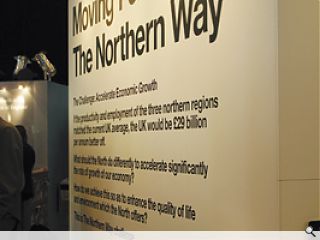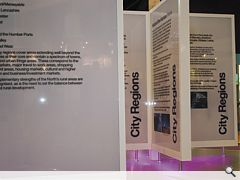Here is a beginners guide to the new government initiative called The Northern Way. The project is less than a year old, but it is already having a major impact on the way funding and public services are being organised across the North of England. I
11 Feb 2005
by Penny Lewis
If you went to the recent Urban Summit in Manchester, you will have noticed that one of the much-talked-about initiatives in government circles is The Northern Way. To most people, The Northern Way means little at present, but if they were to speculate as to its meaning they might imagine that it has something to do with Will Alsop’s imaginative thoughts on the possibility of creating a super-city along the M62 corridor, and stretching on to Hull.
The Northern Way is in fact an administrative initiative, involving the North of England’s three regional development agencies. It is part aspiration and part organisation, but has little to do with Alsop’s ‘imagineering’ except that both the RDAs and Alsop are concerned with the North of England - as a region. The Northern Way steering group has produced a growth strategy based on research of economics, geography, trade flows and patterns of private investment.
The Northern Way is the outcome of an initiative led by Deputy Prime Minister, John Prescott. In February 2004 Mr Prescott invited the three northern RDAs (Yorkshire Forward, Northwest Development Agency and One North East) to look at ways to could the gap between the economy of the North and that of the South. According to economists if the productivity and employment of the North matched the national average, the UK economy would be £29billion better off. While there is little doubt that central government is concerned about nationwide divisions, it is also keen to relieve pressures of growth on the South, particularly in housing, transport and public transport.
The ODPM has come up with the utopian aim of bringing the average output per head of the population in the North into line with the South within 25 years. Among them the three RDAs have a budget of about £800million. An extra £100million has been made available to The Northern Way, to follow key drivers including transport and marketing. The idea is that this £100million will allow the body to lever in about £400million from the private sector.
Critics argue that it is impossible for the North to catch up with the South, because the South continues to grow while the North is still struggling to attract any serious new private investment of a scale that would change the pattern of growth across the UK.
Until now, The Northern Way has been run by the RDAs and the steering group, but government is in the process of appointing a secretariat to administer the body. Vince Taylor has been appointed the director, while the core of the initiative will be run from Newcastle.
The purpose of The Northern Way is to look at the North as a whole and decide whether there is anything to gain from pan regional investment, by focusing on the region’s eight city regions as building blocks for development. The steering group will lobby to influence government spending, but its primary concern is to manage its resources. The group consists mainly of public sector individuals: Professor Drummond Bone, vice-chancellor of Liverpool University and Ed Balls representing ODPM, plus heads of the RDAs and some of the city councils. From the private sector the group has recruited John Roberts, chief executive of United Utilities. Sir Graham Hill is chair of the group and is keen to stress that the body will be lean, will not duplicate the work of others, and will have an entrepreneurial outlook.
At this year’s Sustainable Communities summit The Northern Way steering committee and the ODPM released a report on the progress of the body. It was only four months since the launch of the strategy document, but the group and the ODPM are keen to make rapid progress. Based on research The Northern Way has concluded that the city region is the best spatial unit through which to drive growth, and has identified eight city regions as its focus: Liverpool/Merseyside, Manchester, Tees Valley, Central Lancashire, Sheffield, Hull and Humber Ports and Tyne and Wear.
The steering group identified ten key priorities and a number of achievements, including pilot projects to reduce unemployment (now termed worklessness); the Science Cities initiative (Manchester, York and Newcastle); women into enterprise; some private sector projects in chemicals, advanced engineering and defence; pan-regional transport initiatives; regional spatial strategies; marketing of the North in North America and Australia; and the establishment of a national academy for Sustainable Communities Skills in Leeds.
Running the new initiative will mean rationalising resources. Already the work supported by the RDAs in the arts has been reorganised. They want to create a more entrepreneurial culture and are preparing plans for a Northern Leadership academy, located in the North West. The idea is for each region to lead on certain activities to avoid duplicating work. Yorkshire Forward is now in charge of Marketing the North, and the North West is responsible for Knowledge Base – education, employment and employers skills. Whichever way you look at it, this pan-Northern approach creates another layer of administration and, more significantly, another layer of leadership; both of which can make life hard when trying to drive any initiative forward.
Read next: Think Global, Act Local - The Life and Legacy of Patrick Geddes, edited by Walter Stephen
Back to February 2005
Browse Features Archive
Search
News
For more news from the industry visit our News section.
Features & Reports
For more information from the industry visit our Features & Reports section.




